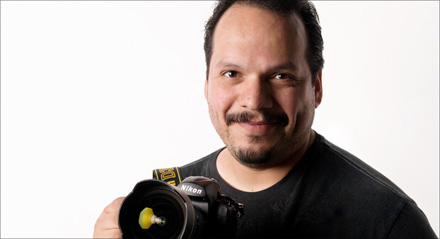
HELLO FROM LAYERS MAGAZINE!
If there is one thing that I am enjoying the most out of the last few years, it’s the evolution of the Creative Professional. In the amount of time it takes us to say “Iomega Zip Disk” we’ve seen incredible strides in technology, expression and reach. There are few places in this planet that aren’t connected to the Internet, and with that – the playing field has gotten wider. Much much wider. My only job here is to hopefully inspire you to see Photoshop as a tool that is a part an entire toolbox you may -already- know how to use.
YOU MAY KNOW MORE THAN YOU KNOW
If you’re adept at Photoshop, you’d be surprised as to how much you may already know about other tools in the Creative Suite. Take Layers for example. In Photoshop, you can take layers and stack them on top of one another and create cool stuff. You can do the exact same thing in Illustrator — masks, filters, and all. Ditto for programs like InDesign and Flash, that allow you to stack stuff on top of one another. In the world of video and audio, these Layers are called Tracks, and their behavior is modified by Levels rather than Masks.
How about Styles? Photoshop uses Styles to be able to repeat a series of specific effects over and over with one click, centralizing these effects in one area (the Layers Styles palette) and giving them a name. InDesign allows you to make paragraph and textual changes using a Styles panel — keeping stuff centralized in one spot. That same technology is called Presets in Lightroom, and in the world of the web, these saved styles are placed in one sheet called a Cascading Style Sheet (CSS).
These programs, while originally designed by competing companies, have technologies and techniques that are cross-transferable. The trick here is to find the commanilities, learn those first, then double back and figure out the rest of the tool to make the next leap – adding another program to your belt.
MONETIZE IS JUST A COOL WAY OF SAYING MORE MONEY
So, why is this all important? Well.. if you’ve spent any time taking a look at the papers, or the Internet, or the TV (it’s pretty much everywhere, actually) you’ll notice that the economy is not doing so well. I’d argue that you’re probably sitting in one of two camps: “How do I keep myself competitive to keep my job” or “How can I take what I know to make more money.”
Photographers, you could capitalize on the emotional high of an event by putting your shoots online – immediately. Get them while they’re cheering, I say. If you are a smaller photography studio, make yourself look bigger than you are by creating an effective website to showcase your work. Better yet, take your pictures and make a video presentation attached to music. Now you’re a “Visual Artist” — that can totally be sold.
If you’re a graphic designer, you can either make a logo, or you can take that logo, place it on a website, develop a couple of multi page layouts, make a mini flash movie with the company’s vision, and sell the entire package. At the minimum, you’d give your client a way to ‘visualize’ your idea in different arenas — helping you close the sale, and making you look more professional for it.
YOU DONT HAVE TO REINVENT THE WHEEL TO DO THIS
A lot of time, people argue that one of the reasons a large part of the Creative Suite is not opened past Photoshop is that it’s “Too hard to get into.” Take Flash for example. Many people want a Flash gallery, but would slam a head against a wall if they knew just how much coding you’d have to learn to make it happen.
You don’t have to learn it though.. Plug-ins and Components are here to help.
I use a lot of Components from Digicrafts Components to do heavy lifting in Flash. Your clients don’t have to know that though… all they have to know is the sweat and tears it took to slave over that SWF file. Well.. not really..
A SMALL VIDEO
So, I made a video and posted it for you guys to check out. I set my computer to record, and just started doodling around the applications. Took about 20 minutes, but in that time, I set a logo, made a business card, made a three page InDesign layout, built a website, added a Flash gallery based on XML to it. In the tutorial, I cover Illustrator, Photoshop, InDesign, Lightroom, Dreamweaver — editing it in Premiere, with a little Soundbooth for music. It’s long because I didn’t want it to be edited — I just wanted to work in the applications, as fast as I could.
You can click on the maximize video, and it will go to a full screen:
There is a more important thing that I wanted to do here with this video, and this is what I want to leave you with:
All of what I did through these applications, you can do with just an introductory class in the Creative Suite applications. If you spent 2 hours an application — you could do the exact same thing.
This is what I do, day in and day out at the office, and what you’ll see when you come to KelbyTraining.com in the coming months. At the core, I’m still a Photographer, and I’m still a Photoshop guy. I’m just more of the background guy – not really working on the sexy portions of the program, but working on the parts that will give me the maximum amount of reach. And I encourage all of you to do the same.
–RC Concepcion


